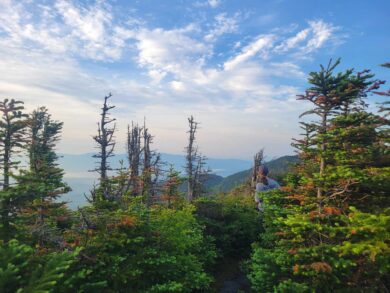
VCE biologists walk the net routes atop Mansfield, photo by Anna Peel
The summer of 2024 marked VCE’s 33rd season working atop Mount Mansfield, and its first summer season banding Bicknell’s Thrushes on Mount Washington since 2011. After 11 visits to the Mansfield ridgeline and seven visits to Washington, a hundred cups of camping-stove-brewed coffee, and countless, gloriously jaw-dropping sunsets and sunrises, our 2024 summer season has finally drawn to a close. And what a season it was!
On our first visit to Mount Washington, the face of the mountain seemed forbiddingly stark—but after two months of regular forays into the wild landscape surrounding Mount Washington’s auto road, each curve of the road now brings with it a new memory of adventure and success. Over the course of the summer, our banding team worked their way up from the forests surrounding Radiator Spring, to the tumbled rocky sweep of Winter Cutoff, all the way to the very last edge of Washington’s tree line at Crag Corner. Each day, as the last cars made their way down the mountain, we would gather up nets and net poles and venture off-road, searching for the perfect places to catch Bicknell’s Thrush.
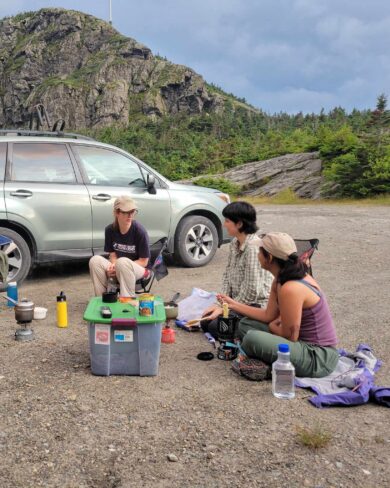
VCE seasonal biologists and interns enjoy a break at Washington Photo by Anna Peel
We began our hunt for Washington Bicknell’s at Radiator Spring, our lowest-altitude banding location on the mountain. Clearings lined with jewel-green mosses and banks of lichen drew us in with their open net lanes, but although this spot was more protected from wind, most of our thrush captures at that altitude were wearing the buffy spectacles of the Swainson’s Thrush. Hunting for higher densities of Bicknell’s Thrush, we moved up the auto road to Winter Cutoff, leaving the balmy meadows of Radiator Spring behind.
The higher altitude favored by Bicknell’s Thrush also meant steeper slopes—one of our strings of nets near Winter Cutoff climbed almost one hundred meters from its start to its highest point! Yet we were not deterred by these conditions, especially when our nets began to fill with female Bicknell’s Thrushes in a slow but steady stream. Each night after capturing birds and banding until dusk, we returned to our cars and took refuge in the wind-protected lot at Radiator Spring. We would then return to our nets at dawn to scramble up and down scree slopes and through the tangled fingers of the Krummholz as the rising sun spread over the valley below us.
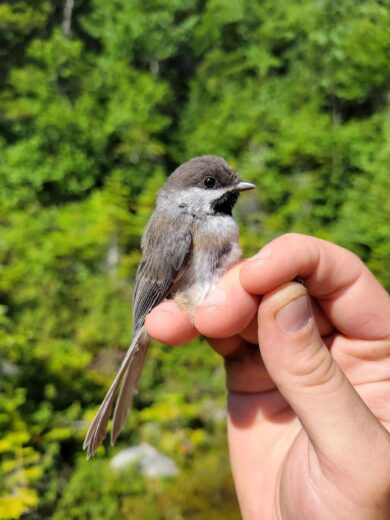
A Boreal Chickadee captured on Washington Photo by Anna Peel
We banded until the auto road began to rumble with the vehicles of that day’s tourists. Our day ended as theirs began, and we scoped out our future net locations before driving back down the mountain, full of excitement for next week’s attempt. Our highest-altitude banding location on Washington this summer was the beginning of the Nelson’s Crag trail. The location was an achingly beautiful spot where our nets ran alongside alpine meadow and moss-edged pools and skirted the very last trees before the mountain gave way to windswept rock. One of the glories of Washington was the opportunity to see Boreal Chickadees up close, as occasional bycatch in our nets – these butterscotch-brown relatives of the Black-capped Chickadee are just as ferocious as their southern counterparts!
After we left Mount Washington for the final time this summer, we had successfully captured, banded, and radiotagged sixteen Bicknell’s Thrushes on the tallest mountain in the East. Six of these radiotagged birds are wearing solar-powered radio transmitters that broadcast a signal for the rest of these birds’ lives. Of the six, four of these solar-powered tags were deployed on female birds. For a species with such a notable male-biased sex ratio, the capture of four female Bicknell’s Thrushes in only seven visits to a mountain with no established net lanes is an awe-inspiring feat! All sixteen tagged birds were broadcasting steady signals when we drove the auto road for the last time. Our Washington birds have already made their journey south to their wintering grounds, broadcasting their path to every MOTUS tower they passed. Fly well, feathered friends – we will be following your future journeys with bated breath!
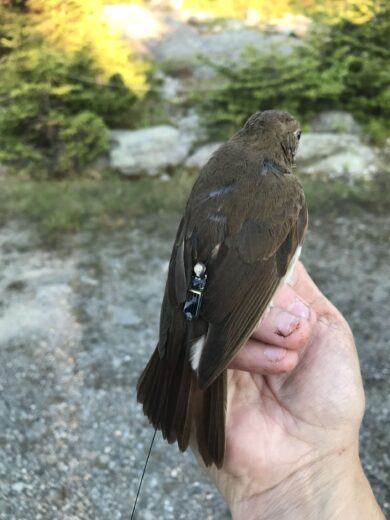
A female Bicknell’s Thrush with a radio transmitter on its back Photo by Desiree Narango
Meanwhile, this past summer marked VCE’s 33rd season hiking the peak of Mount Mansfield in search of birds, and although VCE’s net lanes on Mansfield’s Amherst, Lake View, and Long Trails have been trodden by our biologists for decades, their wondrous potential for new surprises and familiar beauty has not diminished. Over the course of our 11 visits to Mansfield, we banded a total of 541 birds representing thirty-five species. This list included exciting captures like an American Redstart, three Black-and-white Warblers, three Bay-Breasted Warblers, four Canada Warblers, a Chestnut-sided Warbler, two Mourning Warblers, a Scarlet Tanager, a Sharp-shinned Hawk, a White-winged Crossbill, and three Yellow-bellied Flycatchers.
Fourteen female Bicknell’s Thrushes, seven female White-throated Sparrows, and six female Swainson’s Thrushes flew from our palms carrying a lifelong solar-powered radio transmitter harness this season. Two more Bicknell’s Thrushes were harnessed with the traditional battery-powered radio transmitters that will transmit their location for up to a year. Each of these birds carries with her the potential to shed vital new light on the historically male-biased scientific understanding of these species’ life history. Whether the journeys of these 29 birds will be recorded by MOTUS towers, or whether they will skirt detection as they migrate and settle into their wintering grounds, are questions now entirely out of the hands of VCE’s biologists – only time will tell what secrets these birds will show us.
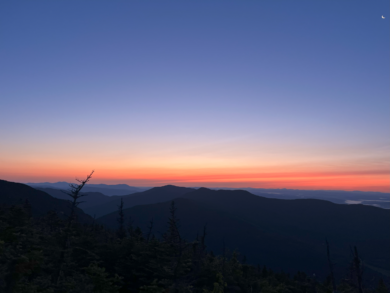
A sunset on Mansfield
This will not be the case for the 13 harnessed and color-banded Blackpoll Warblers that now carry tiny geolocators with them as they embark on their grueling journey across the Atlantic. These black-box geolocators need to be recovered before we can learn anything about the nature of the migratory paths our brave blackpolls have embarked upon, and whether they intersect with offshore wind farms. Until next summer, all we can do is hope that our tagged birds survive the nearly six thousand kilometers of fall and spring migration to return to Mansfield to breed. When summer 2025 rolls around, it’ll be all hands on deck to recapture as many of these precious geolocator-bearing blackpolls as possible. We’ll be keeping our eyes peeled for the bright flash of colorful bands on tiny legs when we return next May – and will be ready to pull out all the stops when we do!

Anna, thank you for this wonderfully vivid account, especially its glimpse of the powerful intersection of science and the lives of birds at this fearful historical moment. The effect is one of hope.
I am also curious just how far you can see from Mansfield’s top (krumholz edge?), what is that body of water in the photo? : ) Veer
We appreciate your interest and encouragement, Veer. It’s especially welcome coming from someone named for the Bicknell’s Thrush call note(?). That’s Lake Champlain in the distance of the first photograph. On a clear day, New York’s Adirondacks and New Hampshire’s White Mountains are both visible from our study area.
Thanks for the descriptive account of bird activity on the mountains in Vermont and New Hampshire, from a new voice at V. C. E! Can you tell us of any recoveries of birds previously banded?
Thanks for your exciting report for this season.
Thanks for this great report, Anna!
Certainly this wasn’t the first time on Mt. Washington for VCE? I hope all that earlier history and data hasn’t been lost. I remember Kent and crew being up there many times in the early 2000s.
Thanks for this continuing effort!
Great to hear from you here Howie! We modified that sentence to read more clearly…nice catch and thanks for remembering all the work from years ago too! All those early years still provide us with an amazing baseline of data on which we continue to build. Hope to run into you one of these days soon. Thanks for your support and interest over the years. Enjoy the nordic ski season!
Thanks, Kent. Good to hear from you, too! Let me know if you’re ever back in this neighborhood and I’ll connect with you when we get over your way next. Cheers!
Beautifully written story- felt like I was there seeing the setting.